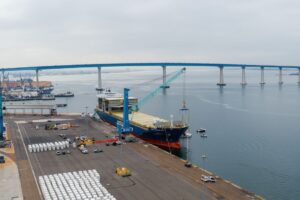Believing that flexibility is essential for meeting the increasing demands of the global shipping industry, the Port of Savannah aims to facilitate flexible and faster-to-market services worldwide from its strategic location along the State of Georgia’s coastline. This prime positioning allows the port to offer weekly container services across global markets, strengthening its role as a major seaport on the East Coast of the United States (US). Managed by the Georgia Port Authority (GPA), the port has continuously expanded its capacity and now hosts the largest and fastest-growing container terminal in North America.
Check out the article in the magazine below:
The Port of Savannah delivers vital cargo and maritime services to shipping lines traversing the Gulf Coast, supported by the Port’s integrated interstate and railroad access that extends across the state of Georgia. For many US consumers and manufacturers, Georgia’s integrated interstate and railroad systems are vital to delivering goods and products across the country on time. Therefore, with the Port of Savannah located at the cross-section between these two vital transportation links, it is primed to support the efficient and seamless delivery of such goods to markets across the US and beyond. Therefore, with the continued support of both rail and interstate transportation links, the Port can continue to expand its shipping footprint to position it as a key port ready to deliver diversified cargo solutions to both US and global markets.
One of the central offerings at the Port of Savannah is the Garden City Terminal (GCT), which is the single largest and fastest growing container terminal in North America. GCT spans a 1,345-operator terminal set on providing quick and easy connections to global markets whilst facilitating seamless supply chains on both a local and international level. The facility encompasses 36 high-speed container cranes and 158 rubber-tired gantry cranes, which are served by Interstate 16 (I-16) travelling from east to west, and Interstate 95 (I-95) travelling from north to south. The interstate routes allow the port to play a pivotal role in delivering cargo along major transport routes travelling across the country. This is valuable as it means many manufacturing hubs in the Southeast and Midwest can be reached via the port in just a couple of days’ drive, and so the port’s interconnected nature with the country’s transport network makes it a clear choice for moving cargo from international markets and across the country.
However, the connected nature of GCT does not end there, and in fact, the terminal is also served by a Class I railway service via CSX Transportation and Norfolk Southern Railroad. These rail network links provide a 2–5-day double-stack rail service that is available to inland destinations across the country, including Atlanta, Charlotte, Chicago, Dallas, Memphis and beyond to service growing markets across the US. CSX Transportation specifically serves the Chatham Intermodal Container Transfer Facility (ICTF), whilst Norfolk Southern Railroad calls at the James D. Masion ICTF. These facilities are owned and operated by the GPA, which is vital in overseeing the entire operation of the Port of Savannah from cargo arriving at the port to shipping it across the country via these vital road and railway routes.
Alongside GCT is the Garden City Terminal West (GCTW), which adds 100 acres of capacity to the Port of Savannah, providing space to store 20,000 containers at the terminal. The storage solutions are offered to importers who are looking for long-term storage solutions. GCTW is serviced by 15 new electric rubber-tire gantry cranes, which add over 1 million twenty-foot equivalent (TEUs) container units to the port’s existing capacity. The terminal provides a state-of-the-art gate which provides easy access for truck drivers to maximise efficiency and convenience across the shipping of the port’s facilities.
GCTW is located adjacent to the docks at the Port of Savannah and the Mason Mega Rail Terminal. The Mason Mega Rail Terminal has been a long-term infrastructural investment in GCTW by GPA to help move cargo to key markets much faster. The rail link provides shipping to these markets in less than 3 days and thus supports the Port of Savannah as the largest intermodal facility in North America, servicing 42 trains a week with an annual capacity of 2 million TEUs. In 2024, the Mason Mega Rail Terminal achieved record volumes, moving 540,850 containers via its rail network, a figure that was up 5.7% from the previous year. Thus, through the fluidity and enhanced network provided by the Garden City Terminals and the Mason Mega Rail Terminal, the port’s infrastructure continues to provide the necessary shipping and logistical solutions to deliver the port’s facilities as a vital hub along the east coast of America.
In addition to the Garden City Terminal, there is the Ocean Terminal, which is one of the central developments for the port over the coming years. The current Ocean Terminal spans 5 berths, which are met with full transportation access across both interstate and railroads. The Terminal is located just 2 miles from Interstate 516 and 10 miles from Interstate 95. Via these roads, cargo trucks can move the cargo from the Ocean Terminal and deliver it across the country efficiently. In addition to road access, the terminal also has integrated rail access via a Class I rail service on the terminal via the Norfolk Southern Railroad. This provides on-terminal service and line-haul service thanks to Norfolk Southern Railroad and CSX Transportation, with on-dock rail access served directly to Berths 1, 2, 12 and 13.
However, as the Ocean Terminal looks towards the future, GPA are currently working on an improvement plan for the terminal. The plans outline the renovation of the berths and the container yard, which will allow the terminal to serve two large container ships simultaneously. The start of renovation work will commence in spring 2025, with the construction of a 1,325-foot berth. This berth will be followed by a second, which is planned for completion in June 2026 and will span 2,650 feet. By enhancing its berth capacity, the Terminal will be able to offer an annual capacity of 2 million TEUs.
In January, the Port of Savannah received four new electric ship-to-shore cranes, which were added to the fleet operating across the Ocean Terminal. With the addition of the new crane, the Terminal now operates 8 Super Post Panamax cranes, designed by Konecranes. These will be vital in helping the port in its development to service two vessels at the Terminals’ berths at once. The Terminal will remain open and operating during the renovation works. In the press release announcing the Ocean Terminal renovation plans, Ed McCarthy, Chief Operating Officer at GPA, outlined that “The completion of this project upgrade in 2028 will enable Ocean Terminal to accommodate the largest vessels serving the U.S. East Coast”. McCarthy continues, ‘Our goal is to ensure customers have the future berth capacity of their larger vessels’ first port of calls with the fastest U.S. inland connectivity to compete in world markets”. McCarthy’s comments highlight the growing role that Ocean Terminal, and in turn the Port of Savannah, will continue to play in delivering the port as a key hub for vessels traversing the East Coast of the US to help facilitate access to the nation’s markets.
Thus, in a further development of Ocean Terminal to enhance its interconnectivity, the GPA board have approved the development of a $29 million exit ramp from the terminal, which will enable direct access to local highway transit to Atlanta. Currently, the ramp is 70% complete and will help support the port’s continued interconnected nature both within Georgia and across the US. We can see that the developments across the Port of Savannah have been largely successful, as in June, the port announced that it had achieved its third consecutive month handling over half a million TEUs. The announcement came as the port concluded May, having handled 500,900 TEUs of containers, which is a 2.2% capacity increase from the same period last year.
With vital expansion and investment from GPA, the Port of Savannah has continued to enhance its infrastructure and, in turn, see a vast increase in the port’s capacity. As the port continues to grow, supported by the rail and interstate networks across Georgia, and beyond across the nation, customers can choose to utilise the Port of Savannah as a key step in their supply chains, knowing all cargo will be moved reliably, securely and quickly thanks to its faster-to-market service record. Therefore, it is no surprise that the port is now the single largest container terminal in America. With investment and expansion planned over the coming years under the ownership and operation of GPA, we look forward to seeing how the port continues to enhance its offerings to see an increasing cargo capacity with each passing month.








